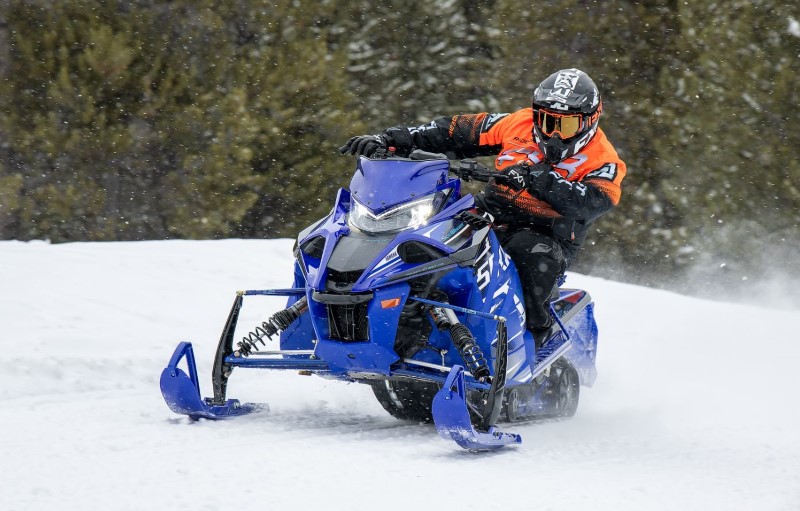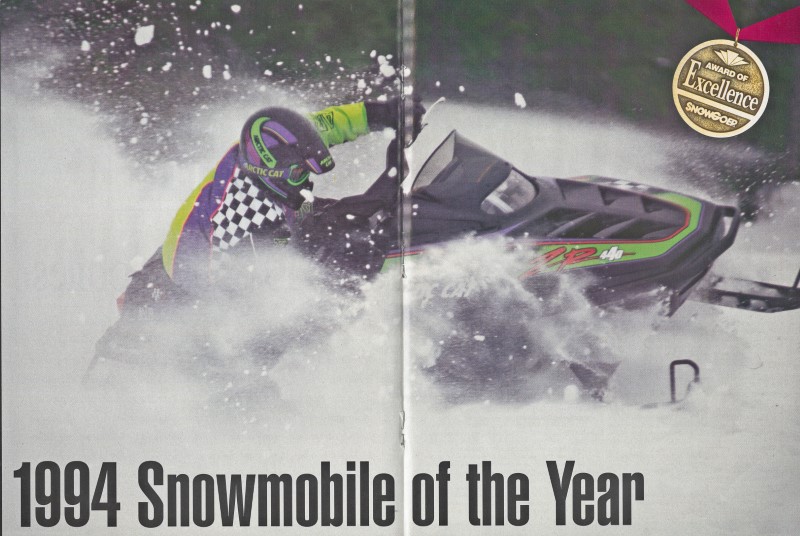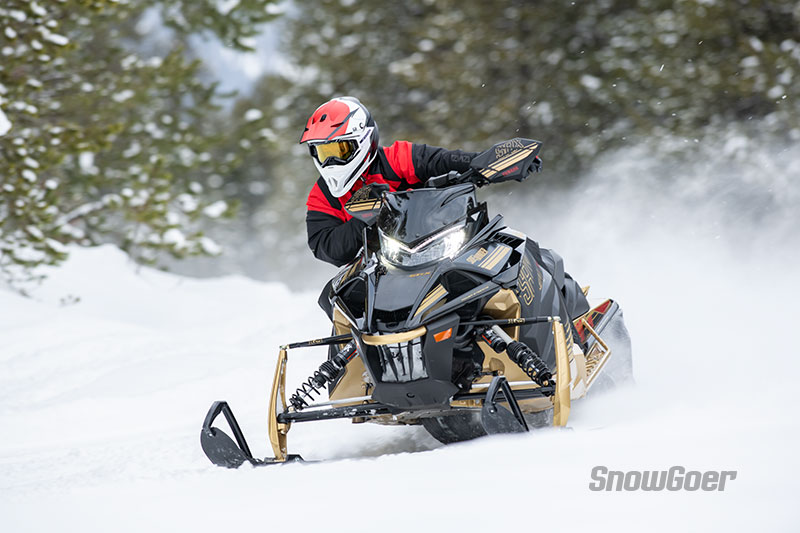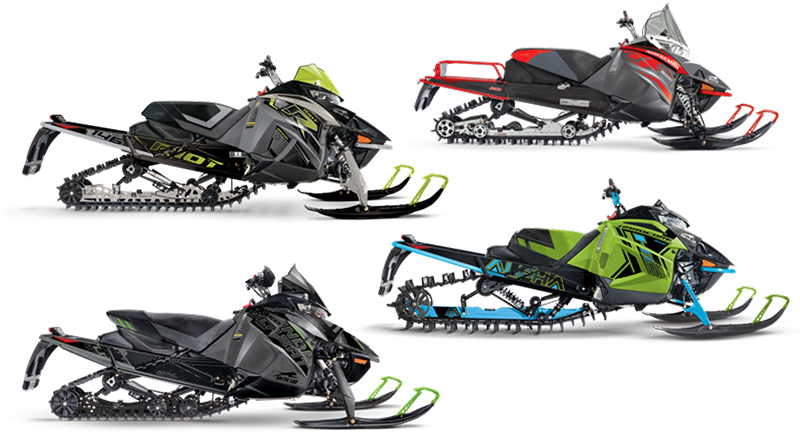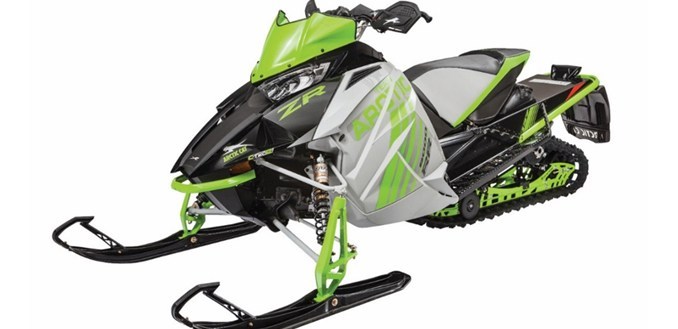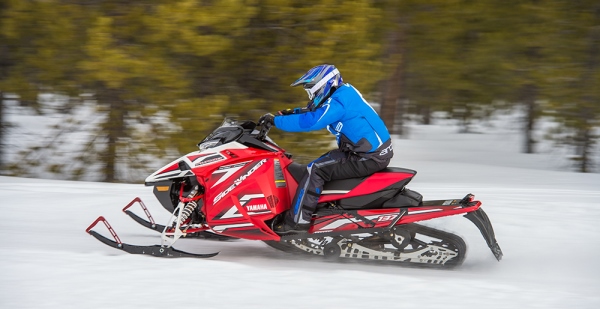 When Arctic Cat released its Sno Pro 500 last spring, the company pitched it as a cost-effective way for people to go snowmobile racing. Cat targeted entry-level racers who would compete in the Sport 85 class of the Midwest-based United States Cross-Country circuit, not to mention some amateur snocross racers across the Snowbelt.
When Arctic Cat released its Sno Pro 500 last spring, the company pitched it as a cost-effective way for people to go snowmobile racing. Cat targeted entry-level racers who would compete in the Sport 85 class of the Midwest-based United States Cross-Country circuit, not to mention some amateur snocross racers across the Snowbelt.
With the new ditch pickle running in the same class as the Yamaha Phazer — which had been a ride of choice in the class since that machine was released for 2007 — a comparison story seemed like a no-brainer.
Both sleds put out roughly 85 hp and are marketed for aggressive riders. But when we took the machines out on the trails for a side-by-side test at our annual Rode Reports event last spring, we quickly learned that these two snowmobiles have personalities and performance that suit the needs of different snowmobilers.
Arctic Cat Sno Pro 500
The Cat Sno Pro 500 fills a void that’s been missing in Arctic’s lineup since the days of the ZR. This is a lightweight machine designed to be ridden hard over the bumps and slinged from corner to corner through the woods. You could argue that the Firecats were for aggressive riders, but handling was questionable and the suspensions were just OK, at best. But they went like hell. The 500 is on the other end of the spectrum – low on power, but high on handling prowess.

Arctic Cat has certainly created a lot of excitement for itself recently with its turbo-powered Z1 sleds, but the new Sno Pro 500 gives aggressive snowmobilers who ride green their due, too. The Sno Pro 500 is a race sled, with the only differences from the machine that Team Arctic racers ride being the engine, shocks, windshield and a few variations in the skidframe.
The front suspension is AWS VIII double wishbone with Fox Zero Pro gas shocks and a swaybar. The rear end is a version of the Slide Action skidframe with Fox shocks. There are minor differences between the 500’s rail and the suspension used in the Sno Pro 600, and it’s geared more toward competition than the Slide Action suspension in F Series trail sleds. The chassis is a tubular chrome-moly and aluminum design with pyramidal construction.
Power comes from a 499cc, fuel-injected twin with dual, 38 mm throttle bodies. Essentially, it’s the same engine that Cat has used in its F5 with revisions to the pipe and fuel-injection to make it work with this chassis. Cat rates it at 85 hp.
Other items found under the hood worth mentioning are a TEAM Industries secondary clutch and oil injection. The sled doesn’t have reverse, nor does it have hood hinges, so riders have to un-strap the hood and set it off to the side in order to fill the oil reservoir. It’s a bit of a pain, but it has a certain racer appeal. The Sno Pro 500 retails for $8,299.
Head Down, Confidence Up
Looking at the Sno Pro 500 tells you it’s all business. It doesn’t have quirky styling like the Phazer. Instead, its short, pointy nose and sharp lines on the hood give this Cat an appearance that its sole purpose is to blast down a high-speed Minnesota ditchline or rip through the woods of Northern Michigan. The Sno Pro 500 is serious about aggressive riding.
This Cat puts its head down and gets to work as it skims through big bumps quickly and efficiently, sapping as little of the rider’s energy as possible. Standing back and watching other drivers go through the bumps on our test ride, the Cat looked calm and collected. It stayed flat and close to the ground, efficiently and quickly getting through the rough stuff rather than bouncing or careening off its line. Front and rear suspension calibrations were void of any soft or hard spots through the full range of travel. “Smooth” is the way to describe it.
The Sno Pro 500 is serious about handling, too. It carves well and goes where it’s pointed without any argument and it turns quickly and precisely. The AWS VIII front end is stable and flat through corners and the new plastic skis bite, hard. The Progressive Steering System (PSS) is a unique setup that seems to work. Steering effort is a non-issue with this sled. The system also reduces feedback through bumps by letting the spindles ‘float’ within the ski saddle as the keel stays true to its line without washing back and forth. It’s a rather low-tech solution from the always crafty crew at Cat’s engineering and race departments – utilizing an exhaust spring where the spindle mounts into the ski saddle – and it really seems to work.
The Sno Pro has a racy feel with ergonomics that put the driver in a mood to work the sled hard. The seat is one of the best for aggressive riders. The narrow front works great for an attacking, on-the-gas-through-rough-turns position and the wider rear portion is comfortable for chilling out. The deep tunnel has wide running boards featuring great foot traction. The low foot position provides a low center of gravity that helps a rider connect with the sled; we felt locked in with the chassis.
Power from the liquid-cooled Suzuki is typical for a low-displacement two-stroke bolted in an Arctic Cat. The engine gives a good response when you’re on the pipe and higher in the rpm range, but it’s short on power and flat to respond down low — like when trying blip the front end over a mogul at about 25 mph.
This was a prototype sled ridden at 8,000 feet above sea level with pre-production fuel mapping and exhaust parts, not to mention the clutch calibrations for elevation that might not have been finalized, so performance could change by the time the sled hits the snow this fall. You can bet there will a good supply of parts from the aftermarket as Cat customers have a fierce appetite for horsepower- and speed-boosting hop ups for their performance-bred snowmobiles.

Yamaha Phazer RTX
The Phazer is one of the most unique machines on the snow. It looks unlike any other machine — sort of a cross between a sport-class ATV and a snowmobile. Plus, while most other entry-level sleds are powered by a fan-cooled, two-stroke engine, the Phazer has a liquid four stroke.
If you’re looking to go out and have fun horsing around on the trails, over big moguls, a rolling field or a drifted ditch, the Phazer is for you. This is a playful, happy-go-lucky sled with a front suspension that works well in big bumps at moderate speeds.
Tucked under the headlight and behind the side panels is the 499cc, twin-cylinder engine that Yamaha rates at 80 hp. Its roots come from the engine that powers the Yamaha YZ250F dirt bike. Engineers essentially hooked two of the single-cylinder top ends to one counterbalanced crankshaft and added fuel injection. Like all other four-stroke sleds from the Japanese manufacturer, exhaust is routed out the back.
Controlled Flow diecast components and chrome-moly tube construction are the backbone of the FX chassis. This manufacturing technology uses vacuum pressure to draw liquid metal into a mold to reduce air bubbles and make the part dense so it can be thinner and lighter. Yamaha calls the driver position on this chassis “sport rider-forward,” which has a tall and narrow seat that sets the rider in an active position that isn’t as aggressive as other makes.
The Phazer RTX has Fox FLOAT shocks in front and rebuildable aluminum Kayaba dampers in the rear suspension. The Dual Shock CK skidframe is a conventional two-shock, torsion spring design with coupler blocks. The track is a 14- by 121- by 1-inch Camoplast Rip Saw. The Phazer RTX retails for $8,299.
Have Fun, Be Happy
The naked styling of the Phazer broke new ground in 2007. Its ATV-style front bumper, bulbous side panels and dirtbike seat hadn’t been seen on a snowmobile, and, as it did three years ago, just looking at it conjures images of happy, lively rides. This machine is built for having fun and playing around on- or off-trail.
Maybe you have land out in the country where you or your teenage kid can make trails or a mini bumps course. The Phazer RTX chassis is set-up for slamming into loose snow and tracked-up fields, and the engine power shines on twisty, narrow trails that require short bursts of corner-to-corner speed rather than long, high-speed pulls.
Through the same stretch of firm, windblown moguls where the Sno Pro showed its cross-country racing skills, the Phazer’s front suspension bounced. The rear suspension absorbed the bumps and tracked right through the moguls. We could play with the chassis; timing the rebound bounce with a pull on the bar helped keep the skis elevated to hang the boards over the bumps rather than hammer through them.
The vehicle has good balance in the air as it continued straight ahead toward our target without tipping to one side or going off line. For riders looking more for high-speed, big-bump performance, they can tune with different shock and spring calibrations, but out of the box the Phazer RTX is set up to play, not race.
At about 85 hp apiece, neither of these sleds is a powerhouse, and at 8,000 feet above sea level where we rode these sleds, their engines were even more short on power. The Phazer’s Genesis 80FI has a broad powerband that pulls well down low where a quick blip of the throttle will leap the sled over a snow bank or mogul. The four-stroke sound rates high on the cool scale, especially in comparison to the high-winding whine of the 500cc two-stroke. Top speed of the two sleds proved nearly identical.
Handling is OK on the Phazer, but it isn’t as sure as it should be, and we blame this on the skis as the machine pushed in corners. More keel would help it carve the snow and hold a line. Fortunately, it’s easy to bolt on aggressive carbides or aftermarket skis to improve control. The sled turns relatively flat with some inside ski lift, but not more than most other sleds.
Ergonomics have been the strong point of many Yamaha snowmobiles recently, and the fit and feel of the Phazer is excellent, too. The handlebar is set at a comfortable height for sitting and standing, and the tall seat makes those transitions easy.
Riders with an inseam shorter than about 30 inches might find the seat too high to lean out for a corner, though. Running board traction is great and the full width that extends back helps when lifting the skis over the big bumps or goofing around. The sculpted side panels are smooth and forgiving when knees bump into them.

